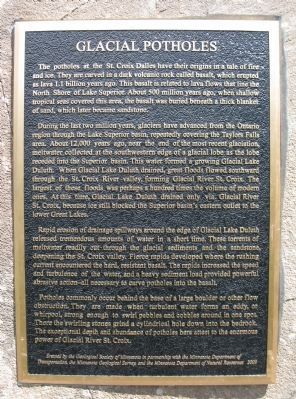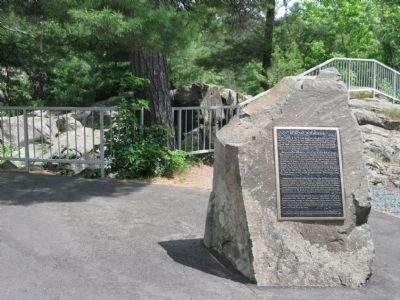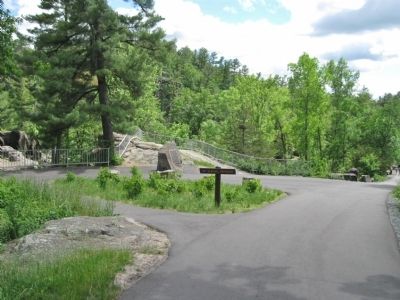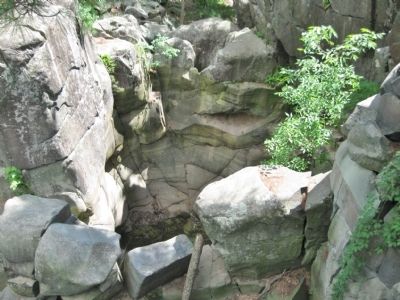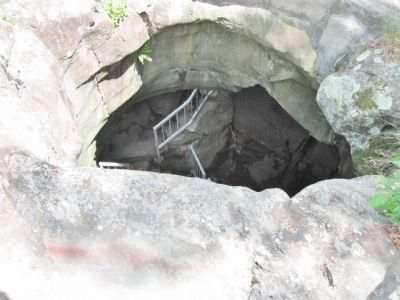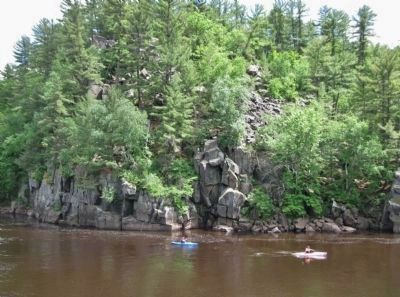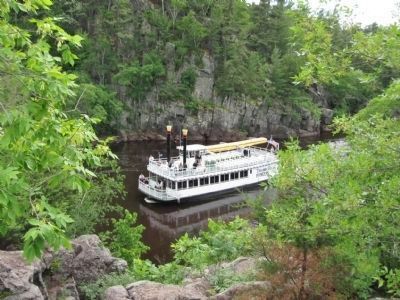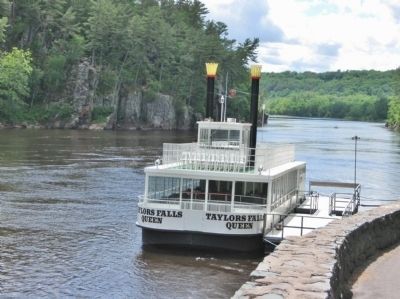Taylors Falls in Chisago County, Minnesota — The American Midwest (Upper Plains)
Glacial Potholes
During the last two million years, glaciers have advanced from the Ontario region through the Lake Superior basin, repeatedly covering the Taylors Falls area. About 12,000 years ago, near the end of the most recent glaciation, meltwater collected at the southwestern edge of a glacial lobe as the lobe receded into the Superior basin. This water formed a growing Glacial Lake Duluth. When Glacial Lake Duluth drained, great floods flowed southward through the St. Croix River valley, forming Glacial River St. Croix. The largest of these floods was perhaps a hundred times the volume of modern ones. At this time, Glacial Lake Duluth drained only via Glacial River St. Croix, because ice still blocked the Superior basin's eastern outlet to the lower Great Lakes.
Rapid erosion of drainage spillways around the edge of Glacial Lake Duluth released tremendous amounts of water in a short time. These torrents of meltwater readily cut through the glacial sediments and the sandstone, deepening the St. Croix valley. Fierce rapids developed where the rushing current encountered the hard, resistant basalt. The rapids increased the speed and turbulence of the water, and a heavy sediment load provided powerful abrasive action – all necessary to carve potholes into the basalt.
Potholes commonly occur behind the base of a large boulder or other flow obstruction. They are made when turbulent water forms an eddy, or whirlpool, strong enough to swirl pebbles and cobbles around in one spot. There the swirling stones grind a cylindrical hole down into the bedrock. The exceptional depth and abundance of potholes here attest to the enormous power of Glacial River St. Croix.
Transportation, the Minnesota Geological Survey, and the Minnesota Department of Natural Resources 2009
Erected 2009 by the Geological Society of Minnesota in partnership with the Minnesota Department of Transportation, the Minnesota Geological Survey, and the Minnesota Department of Natural Resources.
Topics. This historical marker is listed in this topic list: Natural Features. A significant historical year for this entry is 2009.
Location. 45° 23.954′ N, 92° 39.11′ W. Marker is in Taylors Falls, Minnesota, in Chisago County. Marker can be reached from U.S. 8 near Bench Street. Marker is in Interstate State Park (vehicle permit required) beyond the Visitor Center. Touch for map. Marker is in this post office area: Taylors Falls MN 55084, United States of America. Touch for directions.
Other nearby markers. At least 8 other markers are within walking distance of this marker. A Place that Welcomes Many… (within shouting distance of this marker); Folsom House (about 700 feet away, measured in a direct line); First Settlement, buildings, steamboat (approx. 0.2 miles away); Taylors Falls United Methodist Church (approx. 0.2 miles away); Town House School (approx. 0.2 miles away); Chisago Hotel (approx. 0.2 miles away); Geology of the Taylors Falls Region (approx. 0.2 miles away); Interstate Park Centennial (approx. 0.4 miles away in Wisconsin). Touch for a list and map of all markers in Taylors Falls.
Also see . . .
1. Minnesota Department of Natural Resources. Geology of Interstate Park; The St. Croix Dalles, home of the World's Deepest Potholes. "Interstate Park contains more potholes in a smaller area than any other location in the world, and has the world’s deepest known potholes as well... If you look hard and try to count every pothole in the park, you should be able to find more than a hundred of them, all in an area of less than twenty acres." (Submitted on August 24, 2011.)
2. Minnesota Department of Natural Resources. Interstate State Park. "Visitors can climb the cliffs of the St. Croix River Dalles, canoe the flat-water, watch kayakers rush through the rapids, or relax on an excursion boat." (Submitted on August 24, 2011.)
3. Interstate Park. Wikipedia entry. "Interstate Park comprises two adjacent state parks on the Minnesota-Wisconsin border, both named Interstate State Park. They straddle the Dalles of the St. Croix River, a deep basalt gorge with glacial potholes and other rock formations." (Submitted on August 24, 2011.)
Credits. This page was last revised on June 16, 2016. It was originally submitted on August 24, 2011, by Keith L of Wisconsin Rapids, Wisconsin. This page has been viewed 1,902 times since then and 170 times this year. Photos: 1, 2, 3, 4, 5, 6, 7, 8. submitted on August 24, 2011, by Keith L of Wisconsin Rapids, Wisconsin.
